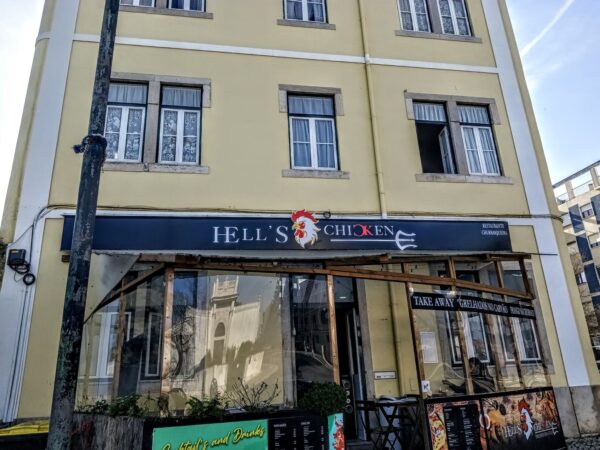But first a confession.
The main focus of today’s post will be my visit to the Museu Nacional do Azulejo (The National Tile Museum) a relatively flat walk along or near the Tejo of about three-and-a-half kilometers each way from and to my flat. (Interestingly, in this instance Google Maps suggested the longer, flatter route rather than the shortest but considerably more strenuous one that required a 79 meter ascent with a corresponding descent.) But first I need to admit that often, even on the days that remain undescribed, my walks have purpose and direction.
Sometimes the purpose is to take supplemental photos for an anticipated blog post. For example, I took the photo of Livraria Alfarrabista Campo de Orique (that appears in the second food tour entry) the day before I left to return to the U S. Sometimes it’s to explore a neighborhood that I hadn’t previously visited and sometimes that results in something that merits at least a brief mention.
Such was the case for my Monday walk to the large shopping center El Corte Inglés where there is a cineplex, where I learned about a huge grocery store called Super Cor, and where I spotted this clever food court restaurant (and where could I feel more at home than in a Portuguese city where people engage in English language puns!)
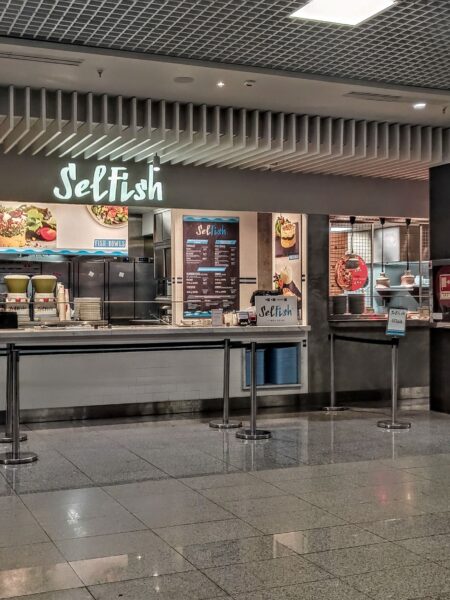
but where I’d gone to see a movie. (Ana had suggested that I try this to help improve my Portuguese since most American films are shown in English with Portuguese subtitles. In this way, I could see how English might be translated into Portuguese. Thinking I wanted short dialog segments and to not have to be too deeply involved in the plot, I chose the rom-com Anyone But You – Todos Menos Tu in Portuguese. And a bargain at €5.40 for a senior ticket to the matinee.) Since this was the first movie I saw in Portugal and I’m reporting on my new activities, I thought I should mention it.
AZULEJOS.
Not just your Buddy’s Blues.
Often blue but not from blue.
Perhaps the most famous architectural element people expect to see when they visit Lisboa are its azulejos – the tiled artwork that has bedecked public and private buildings throughout the city for centuries. You might expect to see work like this
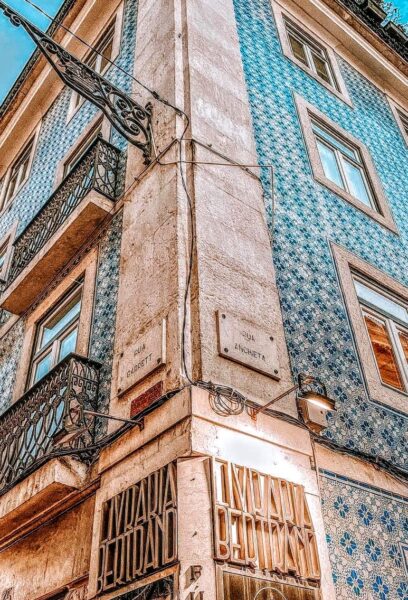
adorning the world’s oldest continually operating bookstore – the Livraria Bertrand in Chiado – or like this tile mural,
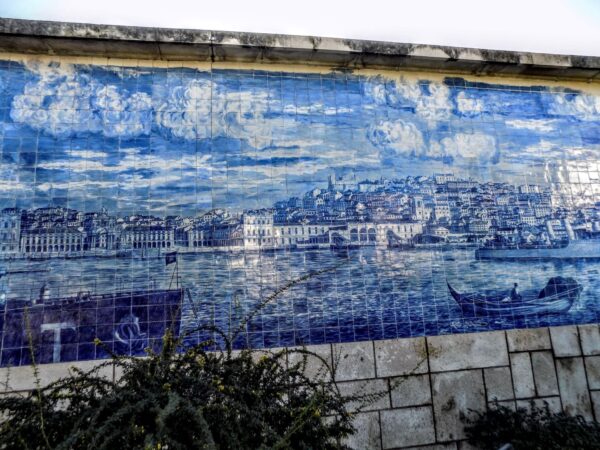
at the Miradouro de Santa Luzia. And certainly, most of the tiles you’ll see in the tourist shops will have elements of blue. Thus, it seems almost natural to conclude that the word azulejo (pronounced ah-zoo-LE-zhoo) is an outgrowth of the Portuguese word azul meaning blue. And if you did, you would be WRONG! It derives from the Arabic aljulej or possibly azulej meaning polished stone. To understand this you have to keep in mind that the Moors ruled not only Portugal but the entirety of Iberia for more than four centuries and you need to know that this type of art and tile work predates even their arrival in this corner of Europe (such as what we saw at the Calouste Gulbenkian Museum).
A short trip for the WABAC.
Normally, I use the WABAC to travel much further into the past than I will today but it’s been sitting idle for so long that I thought I should fire it up. We’re headed back some 2,500 years to 569 BCE, across Europe and part of Asia to the Euphrates River in southern Mesopotamia (present day Iraq) and the ancient city of Babylon. We’ve passed through seven gates as we proceeded through the city and, we see before us the eighth gate – the Ishtar Gate. It’s described in the World History Encyclopedia as “a double gate with a smaller frontal gate and a larger and more grandiose secondary posterior section.” You can see this replica at the Pergamon Museum in Berlin.
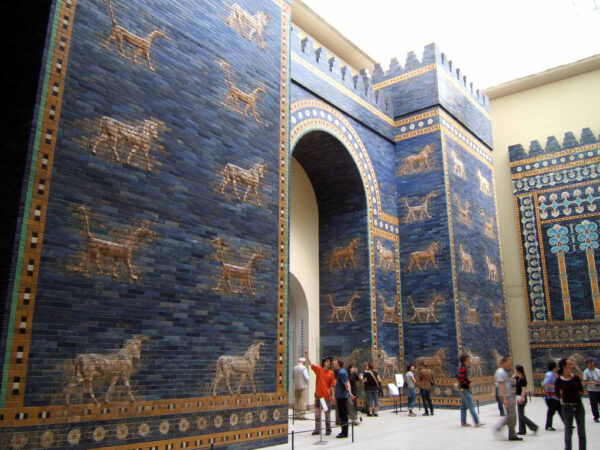
[Photo from WIkipedia By Rictor Norton – , CC BY 2.0, ]
Of course, for now you need only note the predominant color.
While the Romans developed methods of lead glazing in the first century BCE, they used several other techniques such as mosaic, (setting small pieces of stone or glass called tesserae into intricate designs on floors and walls in public buildings, private homes, and temples) fresco (painting on wet lime plaster), and stuccowork (the application of plaster to create relief effects) that they applied to their tile and stonework throughout their empire.
Next, let’s jump ahead into the seventh century. Given the widespread use of tilework throughout the Middle East, it should be unsurprising that the medium would be adapted by Muslims to their cultural norms. As wall tiles using geometric designs became an important aspect of Islamic tile art and religious expression, potters developed a process that allowed their tiles to place a distinctive iridescent finish on the palaces, mosques, and holy shrines that used them. An example is Istanbul’s Sultan Ahmed Mosque called the Blue Mosque because of the more than 20,000 blue and white tiles covering its interior.
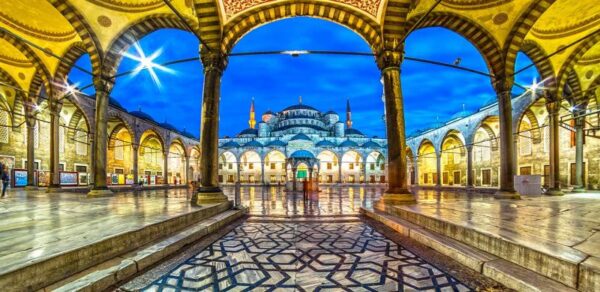
[Photo from Memphistours.]
If you’re wondering why all this blue, you can look to lapis lazuli a semiprecious stone that was thought to have magical powers and a connection to knowledge and insight.
Breaking free from the Moors.
The Moors, of course, brought their tile work to the Iberian Peninsula providing splendid examples of the art at palaces like the Alhambra in Granada. However, following the Reconquista (which ended in Portugal in 1249 but lasted until 1492 in Spain) the Portuguese began to develop their own style of hand-painted azulejos. No longer bound by the Islamic laws forbidding human figures, they began painting their tiles not only with humans but animals, historical and cultural events, religious imagery, flowers, and fruit.
The oldest known surviving Portuguese work is displayed at the Tile Museum. It dates from 1580 and is called Nossa Senhora da Vida. It consists of 1498 tiles painted in a trompe l’oeil style and it’s filled with religious iconography that I don’t understand.
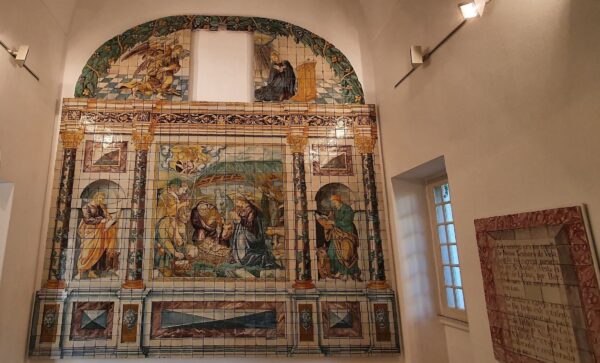
By the 18th century, the Baroque and Rococo movements gave rise to a style of azulejos unique to Portugal – the invitation figure or figura de convite. These were ornate life-size figures, usually a finely dressed nobleman or woman, fixed to the walls of stairways and at entrances to palaces to welcome or invite guests inside. They were a design innovation for the Portuguese because they used outlines or cut-outs rather than the traditional square tile composition.

Then came 1755.
By now everyone should know what happened in 1755 and the critical role played by Sebastião José de Carvalho e Melo – the first Marquês de Pombal – in Lisbon’s post-earthquake reconstruction. Architectural ceramic tiles known as azulejos pombalinos, moved from the interior of churches and buildings to their exteriors – covering public and religious monuments, palaces, stairway walls, houses, restaurants, and gardens. Because of their extensive use in urban housing and the rebuilding of the city, it’s at this time we start to see a new democratization of tiles which had previously been the province of the nobility and the church. To meet the demand, Pombal established the Real Fábrica de Louça a tile production factory in the Rato district that brought mass manufacturing principles to what had been previously done exclusively by hand.
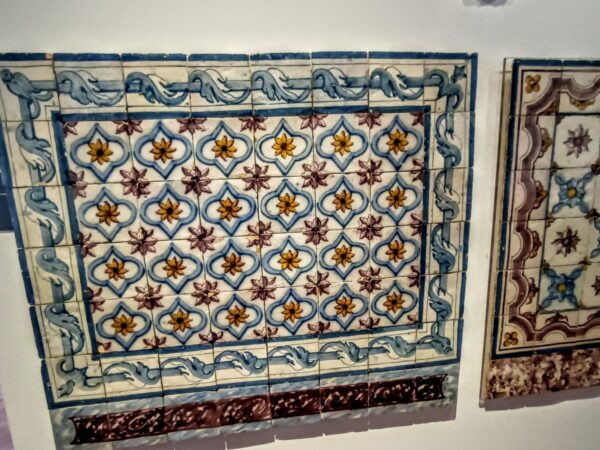
The designs of the 19th century changed to cater to the tastes of a newly emerging bourgeoisie. This class of nouveau-riche and upper middle-class wanted azulejos to reflect their new social status. They decorated the facades of their houses using smaller, more delicately executed tiles that helped keep the interior cool and also reduced external noise.

The museum, of course brings the tradition into the 20th and 21st centuries. In fact, soon after entering the exhibit area, you can see this bit of whimsy,
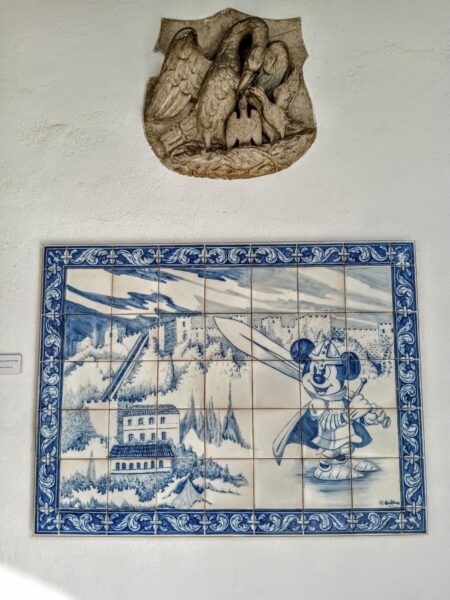
and this more serious work that was a study for the Oceanarium.
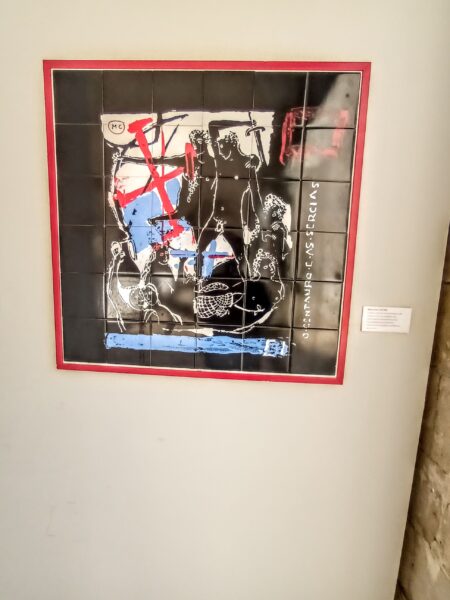
Meanwhile, I hope you enjoyed this brief trip through the history of azulejos and through the museum. My other photos are here.
How many times have I told you no mayonnaise on the chicken sandwich?
The first picture in this post is of a food court restaurant (from which I had lunch) called SelFish so I thought I’d end with another punny restaurant I walked past Goin’ Downtown on my return from the museum. Although I didn’t stop to eat there, I know there’s no mayonnaise on their chicken sandwich because the only chicken on the menu is “Frango da Guia” (Grilled or Barbecue chicken). The name, as you can imagine, is very appealing to me.
